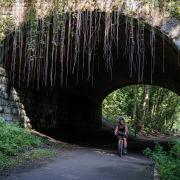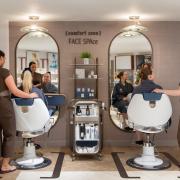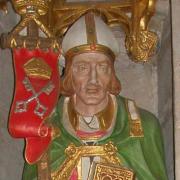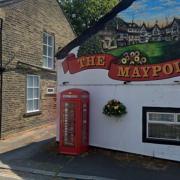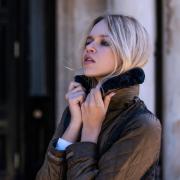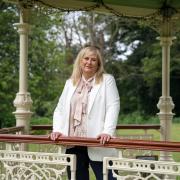Chris Titley visits a Yorkshire college where dressmaking becomes a drama Photographs by Andy Bulmer
Video uploaded by northerncollegeofcostume.co.uk
The print version of this article appeared in the March 2012 issue of Yorkshire Life
We can deliver a copy direct to your door – order online here
The room is large and filled with light from a line of rectangular windows. Once it was a dance studio where young girls would pli� and dream of being in the Royal Ballet – or Girls Aloud.
Today it is home to another branch of showbusiness. For this room, a stitch or two from the fountain in the heart of York, is connected to some of the most colourful and dramatic moments in theatre, opera and film.It is the heart of the Northern College of Costume, a place where students learn how to create outfits for everyone from Covent Garden sopranos to Los Angeles starlets.
Run by Pauline Chambers, a freelance costumier and Hull University’s wardrobe supervisor, the college has been open for only a few years. But already its graduates are working backstage at some of Britain’s biggest theatres – and even making garments for Nicole Kidman.
Hollywood’s a long way from Pauline’s childhood home, the industrial town of Barrow-in-Furness in Cumbria. ‘I used to love costume dramas on TV,’ she said. ‘I remember watching Pride and Prejudice in 1981, not the Colin Firth one, and thinking who designs and makes the costumes?’
This interest led her to Liverpool and a course in costume design, which changed to costume making halfway through. Pauline found she was good at it and, after graduating, found a job as a wardrobe assistant at the Welsh National Opera in Cardiff.
‘They did really wonderful productions,’ she said. ‘Very elaborate costumes – for Othello the fabric was hand-printed in Switzerland, and it was pure silks and linens. There was a lot of work pleating the fabrics before they were made into costumes.’
Pauline moved on to York Theatre Royal for a year in 1986, before stints at theatres in Oldham, Cardiff and Leicester. That brought her to a senior role as cutter at Glyndebourne opera house, a fantastic experience working with director Peter Hall among other big names.
‘It’s very rewarding – especially if you have a whole chorus scene as I did at Glyndebourne once. Designers get their names up in lights and in the programmes, whereas the makers are in the back somewhere. So you’re not doing it for the money or the limelight but for your own satisfaction. It is an art form.’
Since returning to York and turning freelance, Pauline has made costumes for every sort of production. She’s worked on TV shows, including French and Saunders, and film sets such as Harry Potter and the Prisoner of Azkaban.
Whereas theatre designers have a lot of creative leeway, those on TV dramas demand high levels of historical accuracy. Sometimes, Pauline believes, they go too far.
‘I think we might be striving for perfection a bit too much. When you look at old photographs of Victorian men in suits, they don’t fit that well, they’re a bit wrinkly. But if you look at something like Downton Abbey, everything’s absolutely perfect. The nobility would have the wealth to employ these fantastic dressmakers.
‘But then the maid’s outfits are just as perfect too.’
Having been in the profession for 25 years, Pauline knows all the pitfalls – the actor who fails to make a fitting, the short dumpy actress cast in a part which the designer had imagined filled by a tall, leggy one. Many hours have been spent burning the midnight oil making last-minute alterations. But she loves the variety of the job, and certain costumes in particular.
‘I love the bustle gown from the 1870s. because it’s very feminine and elegant and there’s lots of scope for decoration. I also like the Downton Abbey period, around 1910, the hobble skirt – that whole lollipop look, very slim with huge hats.’
She still meets people who assume all theatrical costumes are off-the-peg – ‘they think we might go to Oxfam and get an 18th century frock’ – but in reality each outfit takes great skill and hours of work to create.
Many courses teach students how to design a costume, but few teach the skills to make them.
That’s why Pauline established the Northern College of Costume.For 15 intensive weeks between June and September, a group of students learn all the techniques required to make theatrical costumes. They come with some basic experience, and leave with the skills needed for a wardrobe assistant. All those tricky details – pockets, buttonholes, bindings – are covered, and they also work on three major projects.
The first is a men’s period costume: all the flair of a 17th century Cavalier, for example, or the buttoned-up neatness of the Edwardian chauffeur.
For the womenswear period project Pauline favours the bustle gown ‘because I like it but also because it incorporates so much learning for the student. They’ve got to make a corset, a big bustle cage, a petticoat, a big skirt, an apron, a bodice – all the decoration, the pleating, rosettes, frills and flounces.’
The final project is Hollywood Glamour, where students create their interpretation of a gown worn by the likes of super stars suchj as Marilyn Monroe or Judy Garland.
During the course specialists, including a tutu maker and a tailor, are brought in to pass on their unique skills, and students go on field trips to buy fabrics at Yorkshire mills and in London. ‘The students always say they’re amazed that they manage to learn so much in such a short space of time,’ said Pauline.
At the end of the course in September, an exhibition is held to showcase their finished costumes and portfolios. It’s open to the public and lots of people from the theatre industry attend. That helps them to land jobs in the real world – and the York graduates have gone on to work in remarkably diverse fields.
‘It’s not just opera or film it’s the museums, the cruise liners, the events – people are very into nostalgia. They want jive dresses – the 1940s is popular.’
One of the college’s selling points is its location – ‘they all love York, they love spending a whole summer in this beautiful city with all the festivals going on’ – but graduates end up working all over the world.
‘One girl is working for a freelancer who makes for the Royal Opera House. An American, Maggie, is working for a costume shop in Boston. A French girl, Rebecca, is working for Butlins’ costume department – she’s making lots of big character costumes.
‘One girl has worked at the Globe in London, and she’s just finished making a costume for Nicole Kidman. The film’s released soon.’So next time you’re at a museum, in the theatre or watching a movie, take a closer look at the costumes. That brocaded uniform or Victorian bustle may well have its origins right here in Yorkshire.





